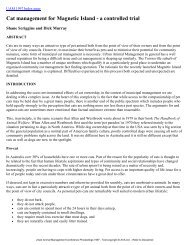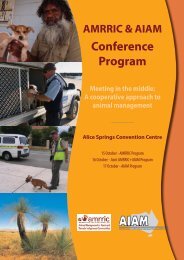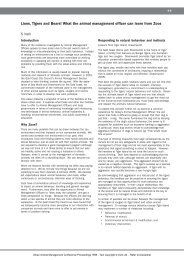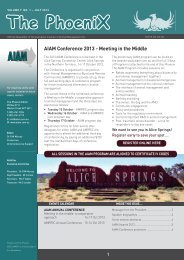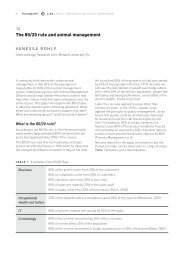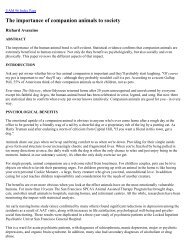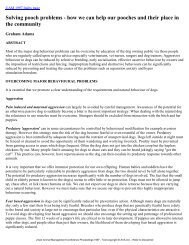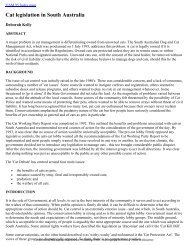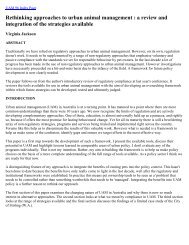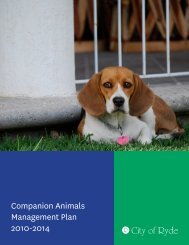Proceedings OF ThE - Australian Institute of Animal Management Inc
Proceedings OF ThE - Australian Institute of Animal Management Inc
Proceedings OF ThE - Australian Institute of Animal Management Inc
Create successful ePaper yourself
Turn your PDF publications into a flip-book with our unique Google optimized e-Paper software.
106 <strong>Proceedings</strong> 2012<br />
AIAM Annual Conference on <strong>Animal</strong> <strong>Management</strong><br />
21<br />
Beach education intervention: Implementation and evaluation <strong>of</strong> a social<br />
change campaign<br />
Dani Scuteri and Vanessa Rohlf<br />
City <strong>of</strong> Charles Sturt, SA<br />
Anthrozoology Research Group, Monash University<br />
Through regular <strong>Animal</strong> <strong>Management</strong> Patrols, the<br />
City <strong>of</strong> Charles Sturt identified the need to address<br />
the issue <strong>of</strong> non-compliance <strong>of</strong> dog owners along<br />
the 13km <strong>of</strong> foreshore. Undertaking a tailored<br />
survey along the foreshore it was identified that the<br />
main issue <strong>of</strong> non-compliance relating to animal<br />
management was dog owners’ lack <strong>of</strong> knowledge.<br />
In collaboration with Vanessa Rohlf from Monash<br />
University the survey results were analysed and<br />
collated to assist in creating a tailored strategy<br />
to address the real issue along the foreshore.<br />
Behavioural observations <strong>of</strong> non compliance with<br />
on leash requirements have decreased since the<br />
implementation <strong>of</strong> the intervention suggesting that<br />
the campaign has been successful in its overall goal.<br />
The implemented strategy will be discussed with<br />
particular attention paid into the preliminary results<br />
<strong>of</strong> the tailored strategy and the observation <strong>of</strong> the<br />
differences in dog owners’ behaviour, knowledge and<br />
perceptions.<br />
Introduction<br />
The City <strong>of</strong> Charles Sturt is located on the western<br />
side <strong>of</strong> the Adelaide City Cbd. It is one <strong>of</strong> the<br />
State’s largest Councils covering an area <strong>of</strong> 5557<br />
hectares with a population <strong>of</strong> 105,573 people and<br />
14,937 registered dogs. Ideally located within the<br />
western suburbs the City <strong>of</strong> Charles Sturt is close<br />
to the City <strong>of</strong> Adelaide, the beach, the River Torrens<br />
Linear Park, the airport, shopping facilities and<br />
entertainment venues. The City is characterised by a<br />
diversity <strong>of</strong> land use having a balance <strong>of</strong> residential<br />
including high density, industrial and commercial<br />
activities; and a diversity <strong>of</strong> people in terms <strong>of</strong><br />
culture, age and socioeconomic character.<br />
One <strong>of</strong> the particular highlights <strong>of</strong> the City <strong>of</strong> Charles<br />
Sturt is its coastline. The City boasts 13 kms <strong>of</strong><br />
coastline which are divided up into six beach areas;<br />
Grange, Henley, Henley South, West Beach, Tennyson<br />
and West Lakes. These beaches are very popular,<br />
particularly in the summer months, and are used<br />
for a variety <strong>of</strong> recreational purposes by the City <strong>of</strong><br />
Charles Sturt residents as well as visitors to the<br />
area.<br />
The Council welcomes dog owners to all six beach<br />
areas. In order to balance the needs <strong>of</strong> other beach<br />
users with those <strong>of</strong> the dog owners the council<br />
allows dogs to be <strong>of</strong>f lead but only during designated<br />
times. These are during the daylight savings period,<br />
before 10am and after 8pm. Further to this when<br />
dogs are <strong>of</strong>f lead owners must ensure that their<br />
dog is under effective control. This means that<br />
the person in control <strong>of</strong> the dog must be able to<br />
demonstrate voice control <strong>of</strong> the dog and it must<br />
be within close proximity <strong>of</strong> and within sight <strong>of</strong> the<br />
person in control <strong>of</strong> the dog.<br />
These requirements are important because they<br />
ensure the safety <strong>of</strong> all dogs and people.<br />
Having received a number <strong>of</strong> complaints (Gorka,<br />
2001; Williams, 2011) concerning non-compliance<br />
with leash laws and nuisance dog behaviour together



